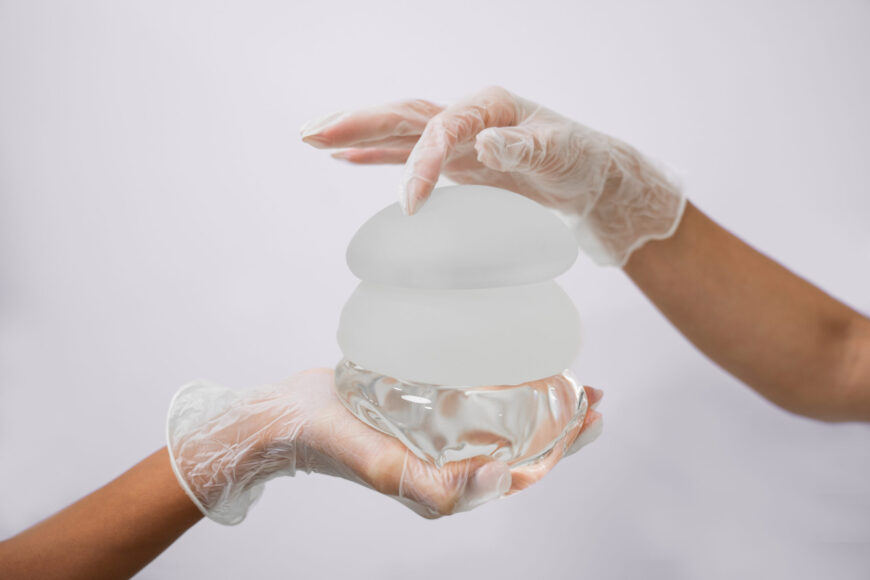| Will I be awake or asleep during the surgery? | Local anesthesia with sedation or general anesthesia can be used |
| Do I stay in hospital after surgery? | Might be needed to stay for 1 night |
| What is the recovery time? When can I return to work/exercise? | Back to work in 1-2 weeks, back to exercise in 2-6 weeks depending on recovery |
| How long will the surgery last? | 1-2 hours |
| How long until the final results of surgery are visible? | 6-12 months after the surgery |
WHAT IS BREAST AUGMENTATION SURGERY?
Breast augmentation, or medically called augmentation mammoplasty, is a surgery that involves increasing breast size. It is the process of placing breast implants under chest muscles or breast glandular.
Generally, breast augmentation surgery can help with:
- Uneven breast
- Breasts that lack projection
- Very small breasts
- Breasts that don’t have the fullness
- Breasts that make poor cleavage
- Breasts that appear uneven
For many women, breast augmentation surgery brings a lot of benefits. Improved physical appearance and increased self-confidence are just some of them.
However, if you are considering surgery for breast augmentation in Dubai, it is important to understand what the procedure involves, what the possible complications and risks are, and what the after-surgery protocol is. Therefore, a thorough consultation about breast augmentation surgery with one of the best plastic surgeons in Dubai is absolutely necessary. Also, it is important to be realistic about what this surgery can do for the patients. Trust our breast augmentation Dubai specialists to come up with the best treatment plan for you.
BENEFITS OF BREAST ENLARGEMENT SURGERY
When the patient decides to enhance their bust at Lucia Clinic with breast augmentation surgery in Dubai, Lucia’s team of plastic surgeons will make a customized treatment plan that will be based on the patient’s goals and expectations.
Breast augmentation surgery improves breast symmetry, which greatly increases the patient’s confidence. The patient can choose the type of breast implant, its size, and the shape of each breast. The surgery provides the patient with an evenly matched breast that will ideally fit into their clothes.
The surgery can add more volume and curves to the patient’s breasts. For women who have naturally small breasts, it can be beneficial to undergo breast augmentation in Dubai because it improves their silhouette with the desired curves. The surgery gives these women a new look and new body contours. Breast implants in Dubai can improve women’s proportions and provide a better-balanced body.
Also, together with breast lifting surgery, breast augmentation can restore a more youthful appearance to women’s breasts and prevent sagging or loss of breast volume.
Women who want to combine breast augmentation with body contouring might choose fat transfer breast augmentation in Dubai, also known as autologous fat transfer or fat grafting. It enhances the size and shape of the breasts using a patient’s own fat.
The method involves liposuction procedure to remove fat from areas like the abdomen, thighs, or flanks, which not only enhances the breasts but also sculpts other parts of the body.
WHO IS A GOOD CANDIDATE FOR BREAST IMPLANTS IN DUBAI?
Ideal candidates for breast implants in Dubai typically include:
- Physically Healthy Women: You should be in good overall health and free from any conditions that could complicate surgery or recovery. It’s essential to be able to undergo anesthesia and heal properly after surgery.
- Women with Fully Developed Breasts: Breast augmentation is recommended for women who have fully developed breasts. This typically means waiting until after puberty, as the breasts need to be stable in size for optimal and lasting results.
- Women Dissatisfied with Breast Volume and Shape: Women who have experienced a loss of breast volume or shape due to significant weight loss, pregnancy, breastfeeding, or aging often consider breast augmentation in Dubai to restore their breasts to their former fullness and shape.
- Women with Naturally Small or Asymmetrical Breasts: Some women may feel their breasts are too small or disproportionate to the rest of their body. Breast implants can help achieve a more balanced and proportional figure, enhancing their overall appearance.

Breast implants in Dubai can be just what you need
If you are considering breast implants in Dubai, it is necessary to have realistic expectations about the outcomes of breast augmentation. While the procedure can significantly enhance the appearance of your breasts, it’s important to understand its limitations and potential risks.
Emotional and psychological readiness is also crucial. You should be doing this procedure for yourself, not to meet someone else’s expectations or to fit an ideal image. During a consultation with your breast implant Dubai specialist, you will discuss all of these points and make the best decision for yourself.
TYPES OF BREAST IMPLANTS IN DUBAI
Choosing the right type of breast implant is a crucial part of the breast augmentation process. At Lucia Clinic, we offer a variety of implant options to meet your specific needs and aesthetic goals. Here are the main types of breast implants available:
- Saline implants
- Silicone implants
- Gummy bear implants
Saline Implants
Saline implants are filled with sterile salt water. They offer several benefits, including:
- Uniform Shape and Feel
- Adjustable Size
- Safety in the Rare Event of a Rupture
Silicone Implants
Silicone implants are filled with silicone gel, which closely mimics the feel of natural breast tissue. Key features include:
- Natural Feel
- Variety of Sizes and Shapes
- Cohesive Gel That Remains Within the Shell Even If It Ruptures
Gummy Bear Implants
Also known as form-stable implants, gummy bear implants are made of a highly cohesive silicone gel. They are named for their ability to retain their shape even when the implant shell is broken. Benefits include:
- Shape Retention
- Natural Look and Feel
- Reduced Risk of Complications
Schedule your consultation at Lucia Clinic today to explore the best breast implant Dubai options to achieve your ideal look in the heart of this city.
WHAT DOES BREAST AUGMENTATION SURGERY IN DUBAI LOOK LIKE?
Breast augmentation at Lucia Clinic is a meticulously planned and executed procedure designed to achieve the best results with minimal discomfort. Check out what the surgery entails below.
Initial Consultation
When the patient arrives at Lucia Clinic, the journey begins with an in-depth consultation with a plastic surgeon. During this session:
- The patient discusses her size preferences and the desired appearance and feel of her breasts.
- The surgeon explains the types of implants available, which are made of silicone and can be round or teardrop-shaped, smooth, or micro/nanotextured.
- Various surgical techniques are reviewed.
- The patient is asked to have an ultrasound or mammogram done before the surgery.
Other details covered during the consultation include:
- Reviewing current medications, with suggestions to avoid aspirin and other blood thinners that could increase bleeding.
- Detailed explanation of the post-operative protocol to ensure a smooth recovery.
Patients are advised to complete all household chores before the surgery and avoid any activities that involve reaching up or stretching post-surgery. It is also important to stop smoking 4 to 6 weeks prior to and after the surgery. Arranging for someone to drive the patient home and stay with her post-surgery is recommended.
Anesthesia for Breast Implant Surgery in Dubai
The type of anesthesia used during the procedure is discussed with an anesthesiologist during a second visit. The options include:
- Local Anesthesia: The patient remains awake while the breast area is numbed.
- General Anesthesia: The patient is asleep throughout the procedure, which is the more common method for breast augmentation.
Incision Options
Once the surgery begins, the plastic surgeon makes a single incision in one of the following three places:
- Inframammary: In the crease under the breast.
- Periareolar: Around the nipple.
- Axillary: Under the arm.
Implant Placement
The surgeon separates the breast tissue from the connective tissue and chest muscles, creating a pocket. This pocket can be:
- Submuscular: Under the pectoral muscle.
- Subglandular: Directly behind the breast tissue.
The chosen implant is then placed into the pocket, ensuring it is positioned correctly behind the nipple.
Closing the Incisions
After placing the implant, the surgeon closes the incision with stitches and covers it with surgical and skin adhesive tape.
The results of breast augmentation are immediately visible, though initial swelling may obscure the final outcome. As the swelling subsides after your breast augmentation Dubai surgery, the enhanced shape and size of the breasts become more apparent.
BREAST ENLARGEMENT SURGERY RECOVERY
Before leaving the hospital, the patient needs to schedule a follow-up appointment to get the stitches and drainage tubes removed (if the surgeon used stitches that don’t dissolve or placed drainage tubes next to the breast area).
In the first two days after breast augmentation surgery Dubai experts performed, the patient might notice that the breasts are heavy and over-enlarged because of swelling. Also, the patient might experience tenderness in the breasts for a few weeks or months. The patient’s nipples might feel numb or too sensitive, and the breasts might be too tight, unnaturally round, or too high. This is a normal part of the recovery process and stops after several months.
The patient is likely to experience swelling and soreness for a couple of weeks post-surgery. Bruises can appear as well. The scars will fade with time, but possibly not completely.
During the recovery period, the surgeon may prescribe pain medication to the patient.
It is very important to follow the surgeon’s recommendation about when to continue with daily activities. If the patient doesn’t have a physically stressful job, she could possibly return to work after a week. However, it is crucial not to perform anything strenuous that could raise blood pressure or pulse for a minimum of 2 weeks.
The patient might need to wear a post-operative bra that helps with the recovery. It reduces bruising and swelling. It also helps with additional support and positioning of the breast implants. The surgeon will advise the patient on how long to wear it after breast augmentation surgery in Dubai. Usually, it is recommended to wear it during the day and night for the first week and then only during the day for 6 weeks.
The patient should avoid sports and exercise during the first week. Strenuous exercise can cause bleeding and increase the swelling of the breasts. After 3 weeks post breast augmentation surgery, the patients can start with some gentle exercise like walking or cycling. Contact sports should be avoided because the breasts will be sore. After 6 weeks, the patient may slowly return to all sports and exercise.
WHY CHOOSE LUCIA CLINIC FOR BREAST AUGMENTATION IN DUBAI
Dubai is a popular destination for cosmetic procedures and treatments because of its state-of-the-art facilities and world-recognized doctors who use the latest aesthetic procedure techniques for the most beautiful results. Lucia Clinic in Jumeirah is one of the best aesthetic clinics in this lively city and stands out as a premier destination for breast augmentation in Dubai thanks to its commitment to excellence and personalized patient care.
Our team of highly skilled surgeons employs the latest surgical techniques and uses top-quality implants to ensure natural and satisfying results. Lucia Clinic’s modern facilities provide a safe and comfortable environment, while our dedicated staff ensures each patient receives individualized attention from consultation through recovery. Our reputation for achieving outstanding cosmetic outcomes makes us a trusted choice for those seeking breast implant Dubai specialists.
TAKE THE NEXT STEP TOWARD CONFIDENCE AND BEAUTY WITH LUCIA CLINIC
Take the first step towards enhancing your confidence and achieving the look you desire. Schedule your consultation for breast augmentation in Dubai today and discover how our expert team can help you transform your appearance with precision and care. Contact Lucia Clinic now to book your appointment.





